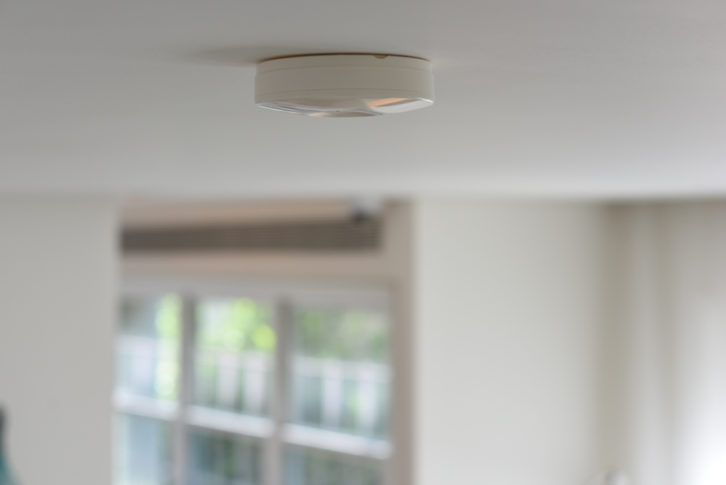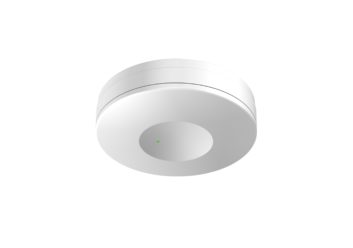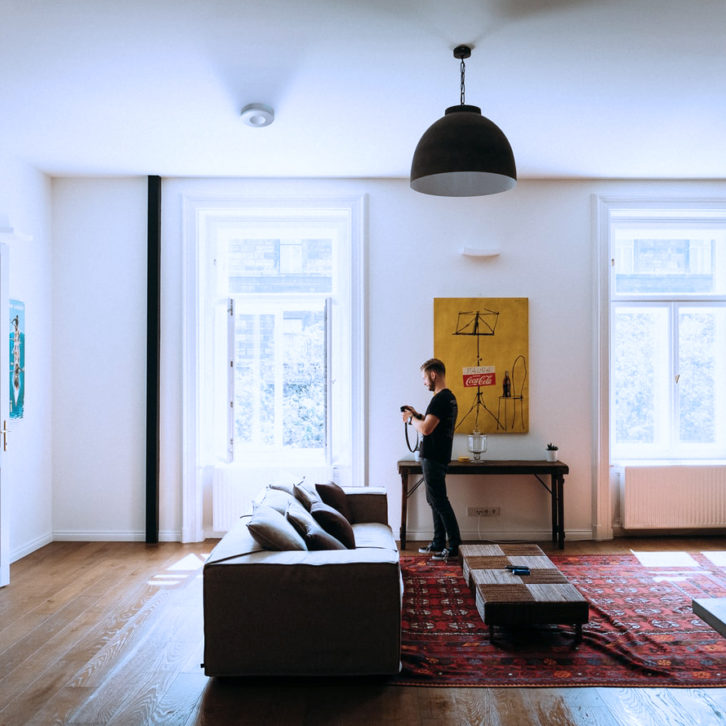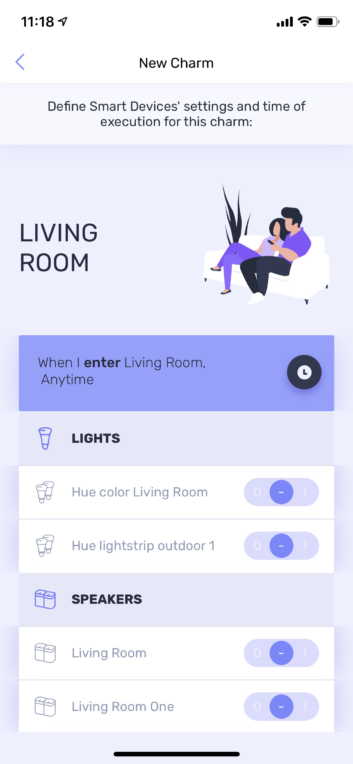Kudos: Simple setup and “Charm” creation; opens up a new level of personalized automation
Concerns: Fairly large form factor will concern some; conundrum of automation event programming that happens every time
 We throw the term “automation” around a lot, but sometimes it is easy to forget that the first part of that word — you know, the “auto” — implies things happening without any user interaction. Sure, we program automation events for our customers, like “every morning, open the blinds,” or “every night turn on the exterior lights,” that don’t require them to do anything, but usually much of our programming involves some customer interaction such as pressing a keypad button, setting the security system, or opening a door.
We throw the term “automation” around a lot, but sometimes it is easy to forget that the first part of that word — you know, the “auto” — implies things happening without any user interaction. Sure, we program automation events for our customers, like “every morning, open the blinds,” or “every night turn on the exterior lights,” that don’t require them to do anything, but usually much of our programming involves some customer interaction such as pressing a keypad button, setting the security system, or opening a door.
And, sure, we can combine these events with layers of if/then programming — if it’s this time of day, or this day of week, or this temperature outside, or the TV is on — but ultimately our programming isn’t very personalized. The keypad doesn’t know who is pressing the button or opening the door, it just fires off the same pre-programmed macro. What if you could truly personalize a system so that it did what each person wanted in each room?
That’s the goal of the new RoomMe sensors by Intellithings, which look to leverage the power of technology most of your customers already own and carry with them to kick off personalized, room-level automation for true “Occupancy Automation.” Unlike a motion detector that can false on a pet or timeout if someone is still, and which can’t tell who is in the room, just that someone is, RoomMe uses the unique Bluetooth signature of a device to identify each person.
After unboxing the first sensor, my first thought was, “Hmm, this is a bit bigger than I thought it would be.” The sensors look a lot like a typical smoke detector, just slightly bigger. Part of the larger size is due to being powered by two D-cell batteries. However, the double-Ds mean that it offers longer battery life — an estimated 3-years — which is always a good thing. Ultimately, once they are installed, you likely won’t notice them. However, we all have those clients that are really sensitive to more “things” on the walls and ceiling, and that might be a concern for them. (Intellithings did share they are working on a new “pro version” of its sensor that will have a recessed form factor and power via 12-volt.)
 The sensors install flat on the ceiling a specified distance from the room’s entry door determined by the ceiling height. (For example, an 8-foot ceiling would have the sensor 4.3 feet into the room, where an 11-foot ceiling would be at 6.8 feet.) The sensor’s removable bracket attaches to the ceiling with two small screws, with the sensor sliding and locking into the bracket, allowing for easy battery changes when the time comes.
The sensors install flat on the ceiling a specified distance from the room’s entry door determined by the ceiling height. (For example, an 8-foot ceiling would have the sensor 4.3 feet into the room, where an 11-foot ceiling would be at 6.8 feet.) The sensor’s removable bracket attaches to the ceiling with two small screws, with the sensor sliding and locking into the bracket, allowing for easy battery changes when the time comes.
While two sensors are the minimum for the system to work at all, you’ll get far more use out of the system the more sensors you install. Intellithings sent me four sensors for this review, but I could honestly use at least three more in my 2200-square-foot home to cover all of the areas where I’d want “magic” to happen. Really, any rooms/areas that have automation capability — lights, fans, music, etc. — could use a sensor. Fortunately, the sensors are affordably priced at $69 for one and $236 for four. The system supports up to 32 rooms and 16 users.
After sensor installation, the RoomMe app is installed on any devices that will be used to trigger automation events. RoomMe supports both iPhone and Android, and at CES the company launched support for Samsung smartwatches running Tizen OS v4.0. (They expect to increase wearable support by adding Apple Watch and FitBit in the future.)
Once the app is installed, it walks you through a process of setting up and calibrating the room sensors with each device. Here each sensor learns the unique BT signature of each device, with the antenna array learning where to track people entering a room. Post setup you can adjust the sensitivity of each sensor. The system utilizes low-energy Bluetooth, which is said to have a negligible effect on device power consumption, and which doesn’t affect the ability to pair with other devices. In order for the system to work, Bluetooth does need to be left on and the RoomMe app needs to be running in the background of each device.
Those with privacy concerns will appreciate that Intellithings doesn’t have a “cloud” that is tracking you; all of the configuration is stored on the local sensors themselves, so no information is sent out of the home. Any time a configuration is changed in the app — new room, new user, new device, new automation, etc. — the “admin” will need to walk around and update each of the sensors.
The system supports quite a few DIY automation products out of the box, including Philips Hue and LIFX lights, Ecobee and Sensibo thermostats, Bose and Sonos speakers, HomeKit, Wink, and Harmony, with support for SmartThings coming. The company also just released (as in about two hours ago as I write this) a new update that enables Amazon Alexa, Google Assistant, and Siri voice integration, allowing you to query the system to find where people are in the home or who is home.
 RoomMe calls its automation “charms” (as in “casting a charm”) and the app allows quickly and easily setting room entry or exit events with any of these supported devices. Charm routines can happen at any time; only during the day, only at night, during specific times (i.e., between 9:00 AM and 2:00 PM), on specific dates only (a birthday or anniversary), or during a specific season.
RoomMe calls its automation “charms” (as in “casting a charm”) and the app allows quickly and easily setting room entry or exit events with any of these supported devices. Charm routines can happen at any time; only during the day, only at night, during specific times (i.e., between 9:00 AM and 2:00 PM), on specific dates only (a birthday or anniversary), or during a specific season.
To avoid conflicts, RoomMe uses layers to define who is “in control” of a room based on room master, parent, and child. So if a child is in a room and a parent walks in, the parent’s programming automatically takes control. But if a parent is already in a room, another parent entering won’t affect what is happening. However, the room master always takes priority, say a child in their own room, or a parent’s office.
When a person leaves a room, the next person with highest priority takes control based on who entered first, and his or her “charms” are cast. This continues until no one remains in the room, and then the room’s “exit charm” is cast.
Unfortunately, most of our projects probably won’t have many of these supported devices on them. (I was fortunate to have two Sonos Move speakers left over from a recent review, otherwise I wouldn’t have had any.) The good news is RoomMe supports integration with Control4, Crestron, ELAN, RTI, and URC via a third-party Chowmain driver. Chowmain gave me a driver license for this review, and this driver is mandatory on any CI project.
Once added to my Control4 project, C4 controller address, I had access to a whole slate of information from RoomMe: Who entered a room, who was in control of a room, who exited a room, who was the last person in the room? With this information, you can literally kick off any automation event that you want based on that information. And this combined with if/then, if/and, or time-of-day programming allowed me to create whatever sorts of programming logic I could think of.
I have quite a few “smart” things in my house — shades, lights, thermostats, fans, audio, door locks, etc. — but the conundrum I struggled with when setting up my RoomMe programming was, “What events do I want to happen every time someone enters a room?”
 I mean, I like music, but having my bedroom speakers start playing music every time I walked into the room — sometimes just for a second to grab something — got old…fast. In the end, I settled on just having lights come on/off when you enter/exit the room, adjusting levels based on time of day, or whether or not my video projector was on, and that worked really well.
I mean, I like music, but having my bedroom speakers start playing music every time I walked into the room — sometimes just for a second to grab something — got old…fast. In the end, I settled on just having lights come on/off when you enter/exit the room, adjusting levels based on time of day, or whether or not my video projector was on, and that worked really well.
Once the programming was defined, operation was seamless and highly reliable, with people just walking into a room and things happening. I didn’t tell my wife about it, but when she walked into our room for the first time and the lights turned on, she said, “Wow, the lights just turned on. That’s cool.” As a “power Nazi,” I love that the lights also now turn off when the last person leaves a room.
One issue we faced in our home was that the rest of my family doesn’t always carry their phones around with them. For example, my wife often leaves her phone on the living room couch, so RoomMe thinks she’s in the living room when she’s often elsewhere, and this would cause lights to turn off in her room when I walked out of it.
Intellithings freely admits RoomMe is not a solution for everybody, saying it isn’t good for families with young children or people that don’t carry their phones with them. (This is why I think the wearables category will be so helpful for them.) But for very connected homes whose family members carry phones with them everywhere, RoomMe opens up a new layer of truly personalized automation that is both unique and surprisingly affordable.
You can learn more at IntelliThings.net.
Product Specs:
Ceiling-mounted room entry sensor
- Bluetooth 4 Low Energy radio
- Powers via two D-cell batteries (user replaceable) with estimated 3-year lifespan
- Native support of popular devices such as Philips Hue, Ecobee, Bose, Sonos, HomeKit, Harmony, ink, and others
- Integrates with Control4, URC, RTI, and ELAN via Chowmain driver
- Dimensions: 6.1-inches diameter x 1.77-inches high
This review originally ran on residentialsystems.com.
See also: Control4 Recognizes Global Dealers And Distributors At ISE 2020













